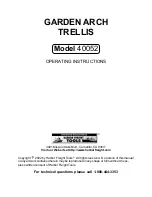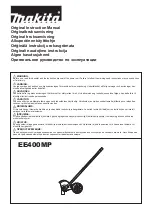
GOS-6200 OSCILLOSCOPE
USER MANUAL
⎯
38
⎯
5-2.Connecting Input Signals
Grounding
The most reliable signal measurements are made when the oscilloscope
and the unit under test are connected by a common reference (ground
lead) in addition to the signal lead or probe. The ground lead of the probe
provides the best grounding method for signal interconnection and
ensures the maximum amount of signal-lead shielding in the probe cable.
A separate ground lead (with a banana plug) can also be connected from
the unit under test to the oscilloscope ground jack on the front panel.
Probes
A probe provides the most convenient way to connect an input signal to
the oscilloscope. The standard ×1/×10 probes supplied to the oscilloscope
are shielded against electromagnetic interference and have a high input
impedance for low circuit loading.
CAUTION. To get the best waveform precisely, keep
probe ground and signal leads as short as possible.
Misadjust probe compensation can cause measurement error. Check and
adjust probe compensation whenever a probe is moved to a different
channel or oscilloscope. As for the probe compensation adjustment
procedure, refer to the “Probe Compensation”.
Coaxial Cables
Signal input cable can greatly affect the accuracy of a displayed
waveform. To maintain original frequency characteristics of the input
signal, use only high-quality, low-loss coaxial cables. Coaxial cables must
be terminated at both ends in their characteristic impedance to prevent
signal reflections within the cable. Use suitable impedance-matching
devices.
GOS-6200 OSCILLOSCOPE
USER MANUAL
⎯
39
⎯
5-3.Adjustments and checks
Trace Rotation Adjustment
Normally, when the trace is in parallel with the center horizontal graticule
line, there will be no need to adjust the TRACE ROTATION. If necessary,
adjust the TRACE ROTATION to make the baseline trace parallel to the
center horizontal graticule line by using a small straight-blade
screwdriver or alignment tool.
Probe Compensation
To minimize the distortion of measured waveforms, check the
compensation of your probes before using them. The probe compensation
should be checked periodically whenever the probes are moved to
different input channels.
1.
Install the probes onto the oscilloscope (Press the BNC connector onto
the channel input and rotate the connector to lock it into place).
2.
Set the probe slide switches to the ×10 position.
3.
Briefly pressing the CH1/CH2 button to set the oscilloscope to channel
1 and channel 2.
4.
Pressing and holding the P×10 button to set the indicated deflection
coefficient of the channel displayed in the readout as a symbol “P10”.
5.
Attach the probe tips to the CAL connection in the front of the
oscilloscope.
6.
Set the oscilloscope controls to display both channels:
VERTICAL: VOLTS/DIV 1V
COUPLING
DC
ALT/CHOP/ADD
CHOP
HORIZONTAL: MODE
MTB
TIME/DIV
0.5ms
TRIGGER:
MODE
ATO
SOURCE
CH1 or CH2
COUPLING
AC
SLOPE











































